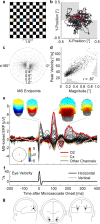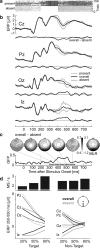Human microsaccade-related visual brain responses
- PMID: 19793991
- PMCID: PMC6666125
- DOI: 10.1523/JNEUROSCI.0911-09.2009
Human microsaccade-related visual brain responses
Abstract
Microsaccades are very small, involuntary flicks in eye position that occur on average once or twice per second during attempted visual fixation. Microsaccades give rise to EMG eye muscle spikes that can distort the spectrum of the scalp EEG and mimic increases in gamma band power. Here we demonstrate that microsaccades are also accompanied by genuine and sizeable cortical activity, manifested in the EEG. In three experiments, high-resolution eye movements were corecorded with the EEG: during sustained fixation of checkerboard and face stimuli and in a standard visual oddball task that required the counting of target stimuli. Results show that microsaccades as small as 0.15 degrees generate a field potential over occipital cortex and midcentral scalp sites 100-140 ms after movement onset, which resembles the visual lambda response evoked by larger voluntary saccades. This challenges the standard assumption of human brain imaging studies that saccade-related brain activity is precluded by fixation, even when fully complied with. Instead, additional cortical potentials from microsaccades were present in 86% of the oddball task trials and of similar amplitude as the visual response to stimulus onset. Furthermore, microsaccade probability varied systematically according to the proportion of target stimuli in the oddball task, causing modulations of late stimulus-locked event-related potential (ERP) components. Microsaccades present an unrecognized source of visual brain signal that is of interest for vision research and may have influenced the data of many ERP and neuroimaging studies.
Figures





References
-
- American Electroencephalographic Society. Guideline thirteen: guidelines for standard electrode position nomenclature. J Clin Neurophysiol. 1994;11:111–113. - PubMed
-
- Armington JC, Bloom MB. Relations between the amplitudes of spontaneous saccades and visual responses. J Opt Soc Am. 1974;64:1263–1271. - PubMed
-
- Armington JC, Gaarder K, Schick AML. Variation of spontaneous ocular and occipital responses with stimulus patterns. J Opt Soc Am. 1967;57:1534–1539. - PubMed
-
- Bach M. The Freiburg Visual Acuity Test—automatic measurement of visual acuity. Optom Vis Sci. 1996;73:49–53. - PubMed
-
- Bahill AT, Kallman JS, Lieberman JE. Frequency limitations of the two-point central difference differentiation algorithm. Biol Cybern. 1982;45:1–4. - PubMed
Publication types
MeSH terms
LinkOut - more resources
Full Text Sources
